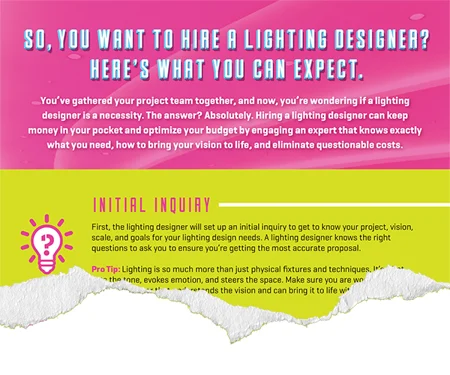
The Lighting Design Process: Aim and Tune
Published by Scott Oldner on Jan. 11, 2024, 4:01 p.m.
The last phase of any lighting designer’s work is to manage the aim of adjustable fixtures and to tune the dimming control levels on the control system. Sometimes this effort is just the lighting designer for smaller projects, but for most projects, it takes the assistance of the electrical contractor and the interior designer. This is where the magic happens. Where all the struggles of design level and budgets have settled, and the fixtures are in the correct location to aim at artwork, sculpture, furnishings, architectural elements, landscaping, or any other item that begs to be highlighted.

AIMING
Remember that lighting design utilizes ambient light, focal light, and sparkle. What we are adjusting in this stage is the focal lighting. What is it that we want you to see, and what items do we want you to see first? We are like flying insects; our eyes draw to the brightest element, and hopefully, that is NOT the light fixture (unless it’s decorative). We want the focus on the objects. Focal lighting is one of the elements that lifts the sophistication level of spaces, creating harmony between light and object. To create that focal element, the lighting level must be at least 10x the ambient lighting. If the average room surface illuminance is 20 footcandles, provide 200 footcandles on the object to be observed.
Focal lighting takes many forms, such as recessed adjustable fixtures, track or monopoint mounted fixtures, linear fixtures grazing a textured wall or pendant lights that uplight an ornate ceiling. Sometimes you only need a few focal elements, and sometimes there are many items in the field of view to highlight. When many elements are highlighted, they tend to reflect light, create their own ambient lighting, and potentially eliminate the need for a secondary set of fixtures. That is a rare condition used only in spaces that want some drama, such as gallery space in museums or high drama residences.
The lighting designer is the director of the aiming effort and rarely touches the fixtures. Usually, the electrical contractor adjusts the lighting during an evening aiming session after dark to get the aiming correct. Daylight contribution will skew how lights aim, so aiming starts after the sun sets. The end of civil twilight is about 20 minutes after official sunset, and that is when the first fixture should be aimed. Then, tuning the dimming can start on the heels of the completion of aiming in each space.

Tuning
If you’ve ever tuned a musical instrument, you can understand that even a tiny movement of the tuning keys can make the difference between beautiful music or hideous noise. Some bands are even ok with hideous tuning (but usually not.) That level of subtlety is required for designed spaces. Small moves in the dimming level for ambient lighting can make considerable changes in the feel of the space. Focal lighting varies more widely depending on personal preference and contrast ratios. Those personal preferences come from the viewers history, awareness, and objectives. In commercial projects, lighting designers set the levels for their personal preferences based on their experience and input from the design team and ownership. In single-family residences, one of the most enjoyable moments involving the owner is when the lightbulbs turn on, and they finally see the power of what they have paid for.
When setting the dimming, lighting designers are “defining the visual hierarchy” and can steer your attention with the light intensity on each element, defining the contrast ratios. The higher the contrast ratio, the more important the object and vice versa. Since the control system is there to balance the visual environment, settings for the various times of day should be employed. At a minimum, the settings should reflect DAY, DUSK (AND DAWN), NIGHT, and LATE-NIGHT settings. Some spaces have direct daylight penetration in the morning and some in the afternoon. As a rule, the higher the daylighting, the more interior lighting is needed for balancing the visual, avoiding eye fatigue. Dusk and dawn are virtually identical. Many other settings are set on single-family residence projects like “VACATION,” “AWAY,” “GOODBYE”, or, “CLEANING” in commercial offices, and “OVERNIGHT” in hotel public area spaces. Motion sensors, astronomic time clocks, and daylight sensors are used to automate the change of lighting throughout the day for hands-off operation.
If this all sounds very complicated, remember that all things take time to get used to. This seemingly complicated technology is there to simplify our lives. Do any of you remember when you used to have to stand up and walk to your TV to change the channel. I’ve only heard of those times ;-)

A MUSICAL ANALOGY
In the end, the lighting designer is the CONDUCTOR of the symphony and, as such, informs the players (groups of lights) whether they are to play loudly or softly. Next time you are at the symphony (and you should go often), think of each instrument as a group of lights. The violins are the art lights, carrying the melody of the tune. The violas are the ambient downlights. The horn section are the wall washers or wall grazers. The tympani are the decorative fixtures…. You only need one kettle drum or triangle to make a statement. Feel the difference between the quiet (low light level) sections of music and the loud movements (high overall light level).
Enjoy music which is the universal international language. Enjoy lighting as music. Listen to all kinds of lighting. Find what genres of lighting you like. Change the channel often. Heighten your enjoyment of lighting, music, and, therefore, your life.
Happy listening and light on.




